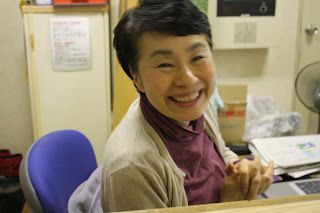The power to capture a moment, a feeling, an emotion.
As a photographer, capturing the perfect moment, feeling, and emotion can be a challenge.
But two influential photographers have mastered this challenge: Annie Leibovitz and James Nachtwey.
Leibovitz and Nacthwey are known around the world for their powerful photographs that all tell a story.
In class, the first film we watched was about Annie Leibovitz.
Annie Leibovitz is an incredible photographer with an amazing story. The films talks a lot about how important family is to her. As a child, her family would move around often and Leibovitz talks about spending a lot of time in the car. Because she claims she was "raised in a car" she "saw the world through a ready made picture frame" and was drawn to photography.
She has an incredible resume that includes work with Rolling Stone, Vanity Fair, and many of the worlds top celebrities.
As visual anthropologists, there are so many things we can learn from Leibovitz's work. Throughout the film, she had a lot of advice when it came to photography. She had said to never have presumptions about anything until you get there. If you have an idea in your mind before you come to the shoot, it will never live up to your expectations and thoughts. You have to keep your mind open.
She has often said that the best photography is what is around you. You become part of it, participate in everything that's going on, and you're living it yourself. When you're engaged in a situation, it's so much easier to photograph and document it because it's up to you how you want to represent that moment.
Photo by Annie Leibovitz, from VanityFair.com
Annie Leibovitz is known for her creative and unique photo shoots, which makes her work stand out even more. The 2008 Miley Cyrus shoot caused a bit of eyebrows to raise in concern, when slightly "racy" pictures of Miley and her father appeared in Vanity Fair.
When asked about how she comes up with her ideas, Leibovitz commented on how she starts out with very simple ideas, some that she considers "stupid". She likes to use ideas with humor and irony, almost to approach the idea of the subject. She likes to incorporate their personalities or what they're known for to create memorable photographs.
Annie Leibovitz's technique definitely works because her photos definitely stand out. She is an incredible photographer with an amazing talent.
The second film we watched in class was about James Nachtwey, who is well-known for his war photography.
James Nachtwey has lived an incredible life. He has seen so much, lived through so many terrifying events, and has photographed his entire journey for the world to see.
Nachtwey said he first wanted to become a photographer after seeing images from the Vietnam War. The images stuck with him and he wanted to do the same - capture images and share them with the world. He wanted the world to see his photographs.
Photo by James Nachtwey, from Time.com
And the world has seen his photographs. This image from September 11, 2001 is powerful on so many levels. A picture is really worth a thousand words.
Nachtwey said that taking photographs is witnessing history, it's seeing thing happen to ordinary people. You really feel the people's emotions. It's similar to theater but the script was being written then, right in front of him. It's impossible to photograph moments without people accepting and wanting you to be there. They realize that photos of them show the world what's going on. In a way, it's like making an appeal to to society and trying to give them a sense of right and wrong.
I found it interesting that Nachtwey talked about needing the people's acceptance and permission for him to be there doing his work. We have been talking a lot in class about getting permission to take pictures, and seeing professionals doing the same thing makes me not so embarrassed and shy about asking people. Permission really is necessary and it's important to do so.
When doing so, Nachtwey advises to be open in approach toward people. They understand what you're doing and if you don't speak the language, body language really does work. Calmness and walking slowly is also important because it shows that you're not rushing to get things done but you're just going with the flow and you're there with them.
Nachtwey was always a part of the action, whether it was during war times or during fights in the street. He really has a passion for what he does and it shows in his photographs, which are really up close and personal.
Annie Leibovitz and James Nachtwey are two of the worlds most influential photographers. Their photographs have open the eyes of many individuals and have really made a difference in the world. As visual anthropologists, Leibovitz and Nachtwey are individuals that we should look up to.
Their amazing and unique photographs are truly visual anthropology at its best.







